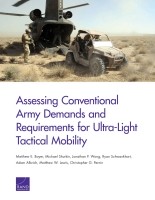| 来源类型 | Research Reports
|
| 规范类型 | 报告
|
| ISBN | 9780833087768
|
| 来源ID | RR-718-A
|
| Assessing Conventional Army Demands and Requirements for Ultra-Light Tactical Mobility |
| Matthew E. Boyer; Michael Shurkin; Jonathan P. Wong; Ryan Schwankhart; Adam Albrich; Matthew W. Lewis; Christopher G. Pernin
|
| 发表日期 | 2015
|
| 出版年 | 2015
|
| 页码 | 200
|
| 语种 | 英语
|
| 结论 |
UTM is often used by Army forces, formally or ad hoc, based on a range of operational factors. - Contemporary operations and operating environments present "bundles" of factors that can favor or discourage UTM employment.
UTM has tactical drawbacks. - The tactical threat is the most difficult factor to offset, and it has routinely outweighed the potential benefits of UTM in the judgment of operational commanders.
UTM capabilities provide a demonstrated alternative to increase operational flexibility through reduction of requirements for delivering an operationally significant force. - Other militaries, services, and individual Army units currently have appropriate and tactically beneficial methods for employing UTM.
Lacking validation, UTM requirements receive little official attention. - While UTM demands do exist for conventional Army units, the lack of tactical unit participation in formal requirements validation processes has left UTM requirements undervalidated, underrepresented, and not fully understood.
- While individual Army units maintain ad hoc UTM capabilities, coordinated Army UTM capabilities are generally nonexistent.
- The Army can develop the basic UTM capability needed with some limited foundational investments.
More systematic Army testing and evaluation is needed to fully assess the operational impact of UTM. - Insufficient metrics, data collection, and evaluations exist to fully assess UTM employment and operational effectiveness or to assess the impact on conducted operations from not having UTM capabilities.
The increasing size of standard service vehicles creates a gap in tactical mobility. - The growth in size and weight of the Army's SSV has resulted in unmet tactical mobility requirements that UTM can address under some circumstances.
|
| 摘要 |
- Refine Army doctrine on tactical maneuver to provide sufficient concepts and technical information for effective and safe tactical UTM employment.
- Develop an Army Techniques Publication or comparable resource that specifically addresses training, planning, employment, and sustainment considerations associated with operational UTM use.
- Develop venues with other services and Special Operations Forces to determine common UTM needs and take advantage of economies of scale for resource-conscious management of UTM capabilities.
- Consider using specialized National Guard units to maintain low-density UTM competencies and experience as a cost-effective method to maintain and transfer core UTM capabilities.
- Develop training resources to establish and maintain basic UTM knowledge that units can flexibly apply to develop and employ UTM capabilities.
- Coordinate training programs and resources with the USMC and SOF to develop UTM training strategies to meet expertise requirements.
- Formally recognize the Army need for some UTM materiel capabilities and define Ultra-Light Tactical Vehicles (ULTVs) as a distinct category of equipment in Army materiel strategy.
- Test and evaluate UTM platforms to identify materiel alternatives that can be tailored to meet requirements across a range of mission profiles for conventional Army units.
- Develop a UTM support program that enables authorized units to satisfy sustainment requirements, especially repair parts and associated equipment sets.
- Provide training and doctrinal resources to enable leader consideration of UTM capabilities and to enable planning for UTM employment.
|
| 主题 | Military Vehicles
; Transportation Technology
; United States Army
|
| URL | https://www.rand.org/pubs/research_reports/RR718.html
|
| 来源智库 | RAND Corporation (United States)
|
| 资源类型 | 智库出版物
|
| 条目标识符 | http://119.78.100.153/handle/2XGU8XDN/107958
|
推荐引用方式
GB/T 7714 |
Matthew E. Boyer,Michael Shurkin,Jonathan P. Wong,et al. Assessing Conventional Army Demands and Requirements for Ultra-Light Tactical Mobility. 2015.
|
|
文件名:
|
x1495316208716.jpg
|
|
格式:
|
JPEG
|

|
文件名:
|
RAND_RR718.pdf
|
|
格式:
|
Adobe PDF
|
除非特别说明,本系统中所有内容都受版权保护,并保留所有权利。